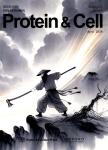Atg7 in development and disease: panacea or Pandora's Box?
Atg7 in development and disease: panacea or Pandora's Box?作者机构:Center for Molecular Medicine National Heart Lung and Blood Institute National Institutes of Health Bethesda MD 20892USA
出 版 物:《Protein & Cell》 (蛋白质与细胞(英文版))
年 卷 期:2015年第6卷第10期
页 面:722-734页
核心收录:
学科分类:0710[理学-生物学] 090603[农学-临床兽医学] 0831[工学-生物医学工程(可授工学、理学、医学学位)] 1007[医学-药学(可授医学、理学学位)] 071010[理学-生物化学与分子生物学] 1002[医学-临床医学] 07[理学] 09[农学] 0906[农学-兽医学] 0703[理学-化学] 0836[工学-生物工程]
基 金:National Institutes of Health (NIH) Intramural Program Leducq Foundation
主 题:autophagy Atg7 mouse model,development disease
摘 要:Macroautophagy is an evolutionarily conserved intracellular degradation system used by life ranging from yeasts to mammals. The core autophagic machinery is composed of ATG (autophagy-related) protein constituents. One particular member of the ATG protein family, Atg7, has been the focus of recent research. Atg7 acts as an Ellike activating enzyme facilitating both microtubule-associated protein light chain 3 (LC3)- phosphatidylethanolamine and ATG12 conjugation. Thus, Atg7 stands at the hub of these two ubiquitin-like systems involving LC3 and Atg12 in autophagic vesicle expansion. In this review, I focus on the pleiotropic function of Atg7 in development, maintenance of health, and alternations of such control in disease.



